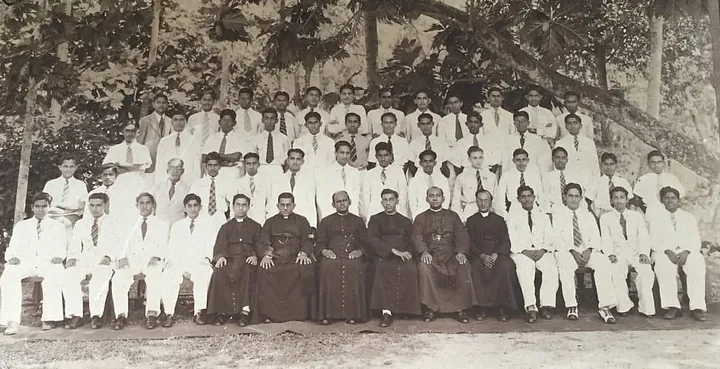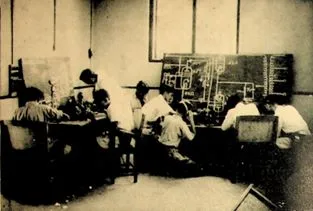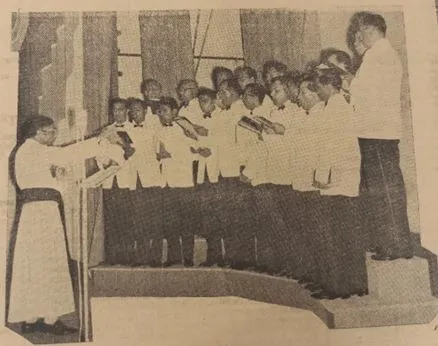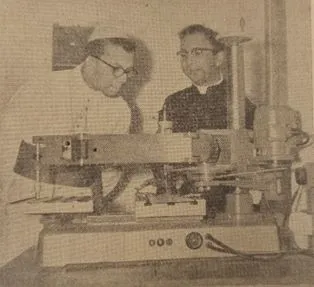Ignatius of Colombo: The Charmed Life of a Genius Priest – By Avishka Mario Senewiratne
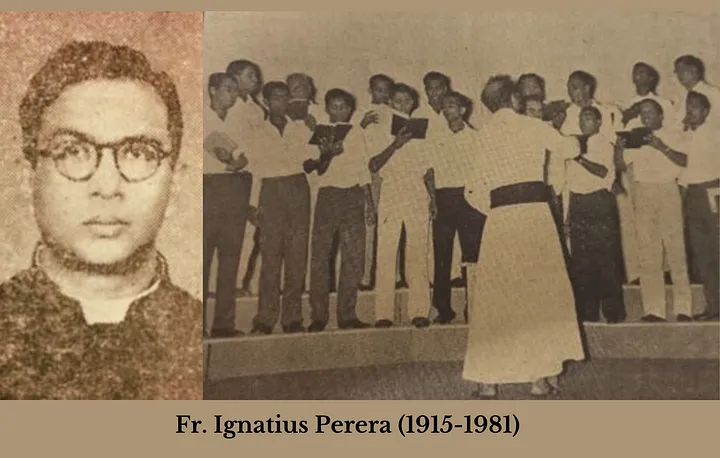
Source:-medium.com
Talent, passion and humility are virtues hard to emulate. Seldom are found, those who have all three. Fr. Ignatius Perera of revered memory, was one such individual born to this palm-fringed isle, Sri Lanka. Some remember him as the Radio priest. Some recall his prowess in training choirs as well as his concerts. But those who were truly touched by his generosity were those who were deprived of hope when they dropped out of school not knowing what to do. For he clothed and fed them as well as educated them, giving them the life they deserved. When he suddenly passed away in January 1981, The Catholic Messenger mentioned the following about him:
“The fascinating personality of Fr. Ignatius should be the subject of serious study by those concerned with the training of pastors…Born into a family of musicians, and schooled in the classics, Fr. Ignatius became an engineer by option, because he had a knack for it, and saw the need for it.”
Though, whether the life of Fr. Ignatius was studied is doubtful, his memory has not faded from those who were inspired by his life and works. Born on October 30, 1915, in the coastal city of Periyamulla, in Negombo, dubbed ‘Little Rome’, Alphonsus Narcissus Ignatius Perera, was born to a family of musicians. His father was Louis Perera and his mother, Egistina Catherine Fernando. His elder brother, Francis would be a priest as well as a Choral Director. While receiving his early education at St. Mary’s College, Negombo, young Ignatius received the calling to be a Priest. His brother’s influence may also have had something to do with his decision. The superiors of young Ignatius such as the seminary Rector, Fr. Edmund Pieris OMI, sounded the brilliant academic record as well as his prowess for music to Fr. Maurice Le Goc OMI, the Rector of St. Joseph’s College at that time. Fr. Le Goc was highly impressed by Ignatius and immediately recruited him to St. Joseph’s. Young Ignatius was known to invent all sorts of creative things in his early days. The scientist priest (now forgotten), Fr. Gregory Goonawardena, played a big role in Ignatius’ early days. Upon completing his school education, Ignatius received the opportunity to study in Rome for his priesthood. The subsequent years in Europe would be a roller-coaster ride for the young man as war intertwined with his formation. However, the delay for the priesthood was one of the best things that would happen for Fr. Ignatius.
The colourful days in Rome
The young seminarian was an outstanding student and well-read in the classics. He mastered several Western languages and was well-conversant with the natives of Italy. Apart from his theological and philosophical studies, Ignatius read for an Honour’s Degree in Classics. Soon after, he got to experiment with two other skills he had not developed in Ceylon. It is unthinkable that a person could balance between sacred music and radio. Yet, this was the niche of young Ignatius, along with his passion for classics. It was through sheer hard work and self-study that he mastered electronics. He truly had a knack for it and doing repairs along with other work brought him great consolation in the Fascist-ruled country. However, there were instances where Ignatius spent too much on Radios and less on Classics. Such as flunking some of his exams! The young Seminarian’s prowess was well-known in the days to come. On one occasion just 10 minutes before the transmission, Vatican Radio broke down. During this time Giulio Marconi, son of Guglielmo Marconi, who was in charge of Vatican Radio rang young Ignatius to come and fix the issue. Within no time, the transmission was active and the radio worked as if brand new. It is also said that Ignatius was called multiple times by a certain priest called Fr. Giovanni Montini for repair work. This priest would later be Pope Paul VI. Another interesting anecdote of Ignatius was when he was in charge of the BTH Super 35mm Arc projector in the auditorium of Propaganda College. He found an ingenious way of modifying the projector motor feed. Thanks to Ignatius, those at Propaganda had the good fortune of watching 35mm feature films. A facility which many others did not have then. He was assisted in the projector room by a German priest and the future Rector of SJC and SPC, Fr. Mervyn Weerakkody. One day while Ignatius was running the projector, he had to urgently run to the washroom. That day the assistants were not present either. Unexpectedly, a fire broke out in the projection cubicle, damaging both the films and the projector. However, the hands of Ignatius were magical. He was able to rewind the burnt transformer and repair the projector. One day the Vatican grounds were full of aero-buffs who had come to fly their model planes. Ignatius found a way of hacking the frequencies of these model aircraft and directed the planes as he wishes, stronger than the controls of the innocent controllers on the grounds. There certainly was pandemonium in the Vatican on that eventful day!
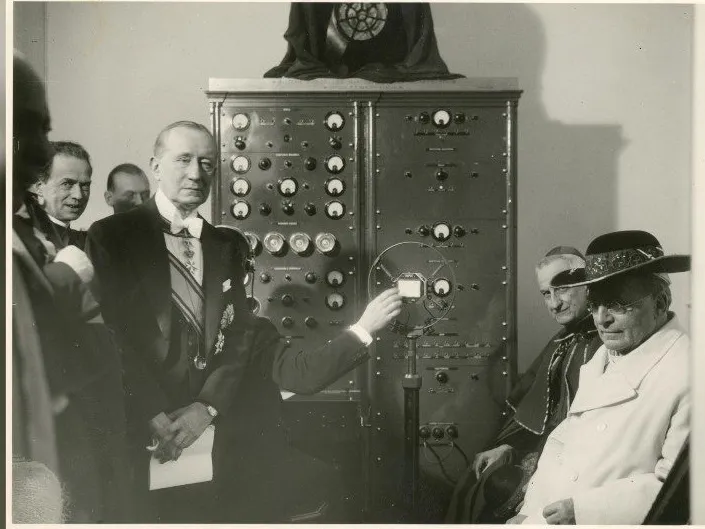
The Vatican Radio was established in 1931 by Guglielmo Marconi during the times of Pope Pius XI
After his formation ended, he amassed a lot of free time. This he used worthily by learning Sacred Music at the Academy of St. Cecelia. Again, through basic teaching and self-study, he also mastered this field. Ignatius surprised all by sitting for the Bachelor of Music Degree at the University of London. This he succeeded with much ease. In Rome, he received one of the rare privileges of conducting the Choir of the Sistine Chapel. With the fall of Benito Mussolini in 1943, Italy was liberated. However, World War II continued for two more years. During these war-torn years, young Ignatius taught Classics to various troupe groups. In the meantime, Ignatius ventured to do a Diploma from Faraday House (An electrical engineering College in the UK), to secure a steady qualification in Electronics. After a long period of gestation, Ignatius and his fellow seminary mates were ordained in Rome on March 19, 1944. He was 27. A year later, Fr. Ignatius was called back to Ceylon and the Archbishop of Colombo, Msgr. Masson gave his first appointment to serve his alma mater.
On the SJC Staff
During this period, St. Joseph’s College had been taken over by the Royal Navy, and the staff and students were located in various parts of the Western Province. Fr. Ignatius was sent to the Borella branch of SJC. Here he had a guide in the person of Fr. Peter Pillai, the Rector. The two of them got along with another contemporary, Fr. Justin Perera would be lifelong friends after the tough days in Borella. The College in Borella adjoining the Archbishop’s House were temporary dwellings and were quite uncomfortable for the boys who had once been in Darley Road. Fr. Ignatius had a reputation that preceded him, for his impetus in what he had achieved in Rome was beyond the ordinary. Thus, his future students expected a certain stature and strict personality. What they saw when this simple priest, not taller than 5’4, rode a barless bicycle to Borella, raised their eyebrows. One of his first students, Peter Perera recalls his first memory of Fr. Ignatius as follows:
“He was an unassuming simple down-to-earth character, affable, youthful, completely approachable almost like one of the students. There was none of the aloofness and authoritarian manner of the teachers we were accustomed to.”
Fr. Ignatius first started taking the Latin class, for this was his first forte. His teaching was contagious and those who resented the subject were enticed to it solely because of him. During the 45-minute period, only 15 minutes were spent on Latin declensions. The rest of the half-hour was to discuss any other subject the students questioned him and his extraordinary experiences in war-torn Europe. Despite this, his students were successful in their exams for he knew the art of imparting knowledge and making students learn in their own ways. Soon he was entrusted with the serious role of Choir master of the almost defunct St. Cecilia’s Choir of SJC. Here is how the 1949 Blue and White magazine illustrate the coming of Fr. Ignatius to the Choir:
“And then 1946 — our new birth, our new home with our new choirmaster. How am I to tell you of those first practices, those practices at which all sorts of strange fish turned up: fish that our little priest had to turn into singing fish? Many of those fish kept wondering what this man was doing to them. Was he trying to ruin them? Making them sing in parts — it may seem exaggerated but I’m sure there were boys — I among them — who did not catch on to the idea of singing while somebody near them seemed to prefer to sing his own composition. Having patiently got each group — Sopranos, Altos, Tenors and Basses — to learn their parts, he found the whole lot lustily singing Soprano! Poor little priest! But in the midst of apparent failure, the messiah had to triumph. In about three months we found ourselves, to our own surprise, actually singing in parts! And that in four parts too!”
Fr. Ignatius’ skill and experience in Rome came into good hands to revive the Josephian Choir. His methodical training and meaningful set of practices warranted success. Soon, the standards had risen to such a level that the students were able to sing over the National Broadcast of Radio Ceylon. The feedback from the general public was overwhelming. The revived Josephian Choristers would now go on to take part in the music competition hosted by the Western Music Section of the Department of Education, and ultimately win it. The judge at this event was D’Hales of Trinity College of Music in London. He hailed the choir for their splendid performance and claimed they sang just as those in England. ‘Handel’s Requiem’ conducted by Fr. Ignatius and performed by the Josephians is considered the greatest of the musical performances the College hosted at that time. The Josephian Orchestra was established in the year 1947, consisting of 16 members (seven violinists, a bass player and a pianist). It was conducted by Fr. Ignatius Perera.
Hostellers in the Borella Branch — 1946 (seated center L to R) Fr. Ignatius Perera, Fr. Arthur N. Fernando, Fr. Peter Pillai, Fr. Noel Perera, Fr. A. Dharmaratne, Fr. Justin Perera
The birth of the Radio Lab
With World War II’s end, most British forces stationed in Ceylon left for their country. The vehicles, weapons, radios and other war-purpose equipment were put up for sale as the forces had little use for them now. Fr. Ignatius, very keen bought a rifle, an army jeep as well as some radios. Whenever he had some, he would often drive in his new jeep to distant jungles in the areas away from Colombo. He had great pleasure in hunting birds and wild boar. On one of his visits to the jungles of Pottuwil, Fr. Ignatius rescued a mongoose and adopted it as his pet. The mongoose named ‘Tikka’ would be with Fr. Ignatius while he would work in the lab and at times when he would teach Latin in the class. The mongoose and the priest became a highlight of the College at that time. Upon the requests of his students, Fr. Ignatius started the Radio Lab of St. Joseph’s College in 1947. The students were very curious about radios, their working and repairs. Soon the membership would reach about 30 or so. Fr. Ignatius taught them the theory of radio and soon made arrangements to let them repair radio sets and make amplifiers. Fr. Peter Pillai trusted this initiative. Soon the Radio Lab made their own amplifier and fixed it to the sound system of the Bonjean Hall. With unprecedented donors and sponsorships Fr. Ignatius’ lab was well-equipped with state-of-the-art technology. No school or lab elsewhere was able to match its standard.
The Radio Lab of SJC
Fr. Ignatius Perera installed a private Intercom telephone system with 24 connections, linking various offices and buildings in St. Joseph’s College. The standards maintained at the Radio Club were extremely high, and the services it rendered outside school were magnanimous. The Radio Club installed amplifiers that were manufactured at the College Lab in some of the popular churches on the island, such as St. Mary’s Church, Bambalapitiya, All Saints’ Church — Borella, Our Lady of Mount Carmel Cathedral — Chilaw and St. Mary’s Church, Negombo, as was a large amplifier system of 180 Watts output for the church and camp of St. Anne’s Shrine, Talawila. A giant 27,000 Watts transformer for a 3-phase electricity supply was also built under the guidance of Fr. Ignatius. For all his work in the lab, Fr. Ignatius had his very own golaya in the person of Aloysius, a young man who was starving in the streets, with his hopes down and his future shattered. Fr. Ignatius employed him and they would have a lifelong friendship. Ignatius and Aloysius were workaholics who slept less and mostly on the table of the lab. The ‘equipment hospital’ was messy strewn with damaged radios, clocks, refrigerators, toys, and gramophones. However, whatever was admitted to the lab, was restored by Fr. Ignatius. This is how Noel Crusz, a good friend of Ignatius illustrated the latter:
“Ignatius smoked ‘Peacock’ cigarettes end to end. His fingers were brown with nicotine. He had his tot of double-distilled Mendis special. He was generous to a fault, especially to those seeking advice on equipment, electronics, music or the classics.”
The humble genius
Fr. Ignatius as mentioned was a brilliant teacher in whatever he taught. However, with all these talents what made him special and loved by all was his zeal to the Almighty and care for the needy. His devotion to the downtrodden made him a veritable angel for those who had once lost hope in life. Fr. Ignatius was a simple man who had a unique sense of humour. He was childlike and lovable. Such traits are not that common in modern society. Chaplain Raja Pereira, a student of Fr. Ignatius relates an important story on the latter:
“One day, during class Father wrote on the board this equation: V = I x R and asked ‘What is this, son?”. I was still fresh with our B1 class’s Physics teacher Sir Eric Mendis’ Electricity lectures and so I soon put up my hand and said ‘Ohm’s Law, Father’. Fr. Ignatius responded ‘No sana boy this was God’s Law which Ohm happened to discover’. It was from here that we learnt that one should put what God said at all times ahead of what man says.”
In the early 1950s, Fr. Ignatius started the famous Catholic Choral Society consisting of young men and women from various parts of Colombo. Ruth Van Gramberg, my good friend living in Melbourne, wrote to me recently relating her experience in those endearing days of the Choral Society. She mentioned that the maestro regularly trained them and received many opportunities to perform at Radio Ceylon. She recalled how Fr. Perera would be invited to perform in public functions with the Choir. Once the choir had performed for Premier Sir John Kotelawala at his Kandawala Walauwa. On many occasions Fr. Ignatius paired with the like-minded mediagenic Fr. Noel Crusz. They partnered in several plays where Fr. Crusz wrote the screenplay and Fr. Ignatius directed the music. Those performances were attended by hundreds and sometimes in thousands. In 1956, the sound editing for the feature film Little Bike Lost, directed by Fr. Noel Crusz was done by Fr. Ignatius and his students in the radio lab.
Fr. Ignatius Perera conducting the Catholic Choral Society
The Kotahena Radio Lab
One of the greatest supporters of Fr. Perera was Mrs. Edith (J.L.M.) Fernando of Pegasus Hotel fame. She, through her son Lalin had come to know him quite well and lobbied those in the Church to aid his good work. Edith Fernando had convinced Fr. Peter Pillai to recommend Fr. Ignatius for a USIS Scholarship in the USA. This move paved off well and Fr. Ignatius was allowed to travel to USA and Europe for his studies in 1960. One area he extensively studied was the new development in electromagnetism. Upon his return, Fr. Ignatius had plans to start a new radio lab. Archbishop Thomas Cooray supported this ideal wholeheartedly and made plans to form the lab in Kotahena, near the Cathedral. In 1962, after donations from many of his friends, students, and especially the Philips Electric Company, the Radio Lab was ready. It was blessed and opened by the Archbishop. This multi-story building was to make men and not records. Fr. Perera was very keen on recruiting school dropouts who did not have any hope in academics. Vocational studies such as electronics came out to be a useful option.
Opening of the Kotahena Radio Lab in 1962 by Archbishop Cooray
Despite his high level of intelligence and ability to do multiple things, Fr. Ignatius Perera, was a simple, down-to-earth presbyter. His devotion to the poor and downtrodden was well known. It was customary for him to help anyone for nothing in turn. On one occasion, when Fr. Justin Perera was admitted to the open ward at the General Hospital. He noticed that one child in critical condition was being put on an iron lung (a mechanical ventilator). To make matters worse, the iron lung failed and those in the hospital were unable to fix it. While the child’s life was ebbing away, Fr. Justin called Fr. Ignatius for help. It was 10 in the night and Ignatius was naturally up doing work in the lab. When answering the phone Ignatius said, “Justin, I have never seen an Iron Lung in all my life”. Fr. Justin countered it by saying, “That does not matter one bit. You just come along”. Within a few minutes, Fr. Ignatius arrived at the scene and in just a few moments he fixed the failed Iron Lung with just the help of nothing but a little strip of bamboo! Such was his interest in those in distress and his divine ability to fix things one deemed unfixable. Fr. Justin in his writings discusses while he was editor of the Ceylon Catholic Messenger, one of the printing machines of the Colombo Catholic Press had failed when an important publication was being printed. Again, Fr. Ignatius fixed the impossible, though printing machines were not his expertise. On another occasion, when a large foreign ship was docked in the Colombo Port, its radios failed. The government of Ceylon trusted none but this genius priest, who once again fixed the matter with relative ease. Stories of Fr. Ignatius can go on and on. This is what makes him legendary.
The end of a life and birth of a legacy
Towards the last years of his life, Fr. Ignatius failed in his sight and became very solitary. However, only a year before his death, he received a Doctorate from MIT (Massachusetts Institute of Technology) with no Bachelor’s or Master’s Degree. Such was his recognition. Fr. Ignatius Perera passed away from a Heart Attack in his room in the Kotahena Lab premises on January 1981 aged 66. Many from various parts of the island came to pay their final homage to this much-loved and talented priest. President J.R. Jayawardena granted special permission to let Fr. Perera be interred on the premises of the Lab. Today a statue has been erected in memory of him and his yeoman contribution to the country. Whence cometh another?
………..
*this article is a by-product of my other research on various other subjects over the last 6 years.
I have referred to many articles and newsletters published in the Ceylon Catholic Messenger during 1950 to 1981. Other state papers have also been referred as well as well interviews with those who knew the man have helped me to gather sufficient information to write this piece. Special thanks to Archdiocesan Archives of Colombo, The National Archives of Sri Lanka, Oblate Archives in Kandy, et al.



